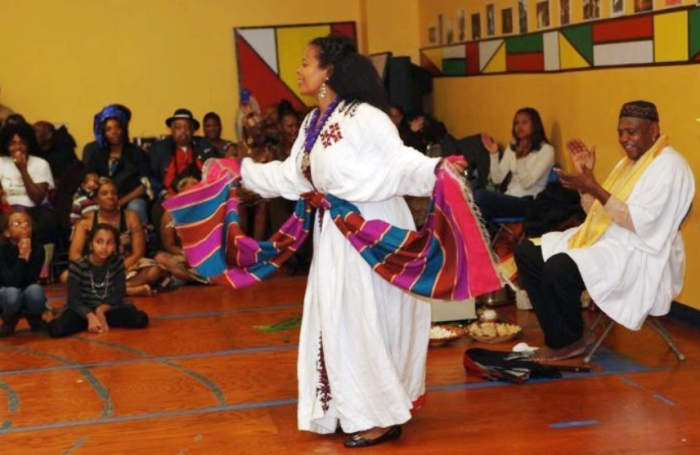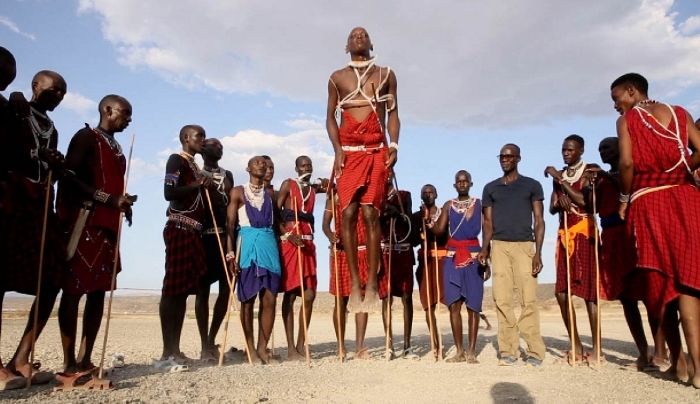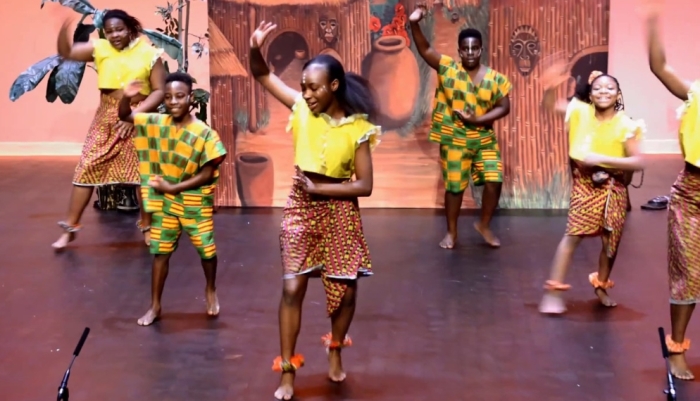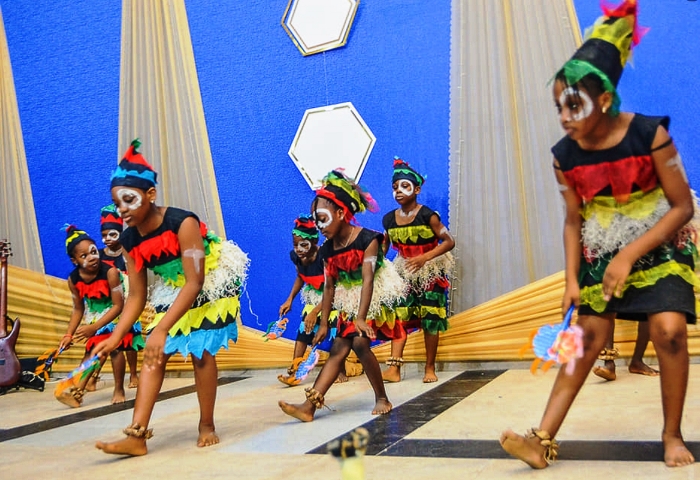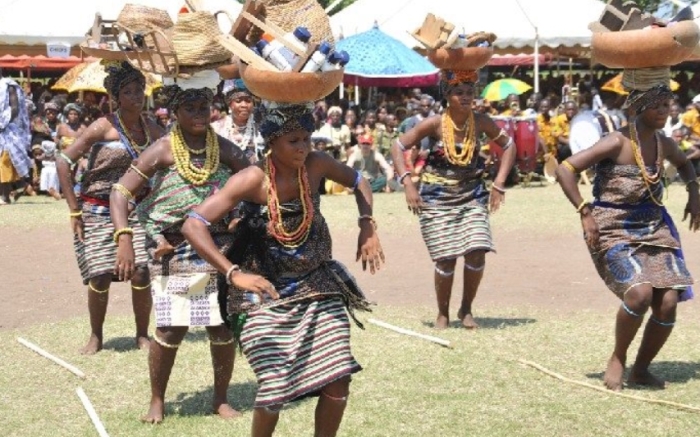How can we talk about Africa and its culture without discussing the energetic, symbolic, and unique traditional African dances?
Today, let’s take a deeper look into the origin and the meaning of some popular dances that have survived the changes in history and successfully spread their influence to the world.
Table of Contents
10 Best Traditional African Dances To Watch
Zaouli Dance
The central area of Ivory Coast highly values the Zaouli dance as part of its tradition. The first time stamp of Zaouli traces back to the 1950s and the signature mask was believed to have been created around this time.
Although the origins of the mask vary, most agreed that Djela Lou Zaouli (Zaouli, the daughter of Djela) was the inspiration for it.
However, the main dancer in a Zaouli performance is always a male.
In the villages of Guro, the Zaouli dance is a crucial custom during celebrations and even funerals. It is a symbol of unity and productivity for the whole village, further expanded to the entire country.
You can find a lot of short clips of this dance on the internet, often with fast-paced and trendy music.
You’ll love: List Of 16 Philippine Folk Dances
Eskista Dance
The Eskista dance has over 20 varieties with exclusive origins and stories, though most of them revolve around farmers in the highlands of Ethiopia and the tough life they live.
It might explain why the customs in different versions aren’t too far off from one another.
The signature movements of Eskista include a lot of motions of the upper body. You will see the dancers craning their necks in different directions, jilting their chests, and bouncing with their shoulders.
In terms of technique, Eskista is one of the most challenging.
The most common accompaniment for Eskista is traditional Ethiopian music, yet you will find more videos with modern music nowadays. This helps to spread the influence of the dance further!
Adumu Dance
Also known by the name Masaai Jumping due to its origin being heavily tied to the Maasai people, the Adumu dance impresses the audience with acrobatic and energetic sequences.
The history behind the dance remains in a mysterious fog of past events. Many experts believed it was a form of training for stamina and agility, hence the first performers were young Maasai warriors.
Eventually, Adumu became more associated with significant and ritual occasions.
Viewers of the Adumu dance tend to have their breath taken away when the dancers in colorful outfits and gorgeous jewelry stand in a circle and showcase continuous jumps.
The dance is naturally competitive as dancers display the extreme of their abilities.
Kassa Dance
Kassa originated from the Northeastern region of Guinea and thrived within the Malinke group of people. In their language, Kassa means a granary, a warehouse for separated grains.
In the old times, when farmers gathered and harvested from the fields, they needed to be supported by Kassa drummers, or the harvest wouldn’t be going smoothly.
The dance only started after they returned to the village and then organized a celebration.
Another custom related to Kassa is the prettiest maiden of the village hanging a shawl on a pole and placing it out in the fields. Whoever got the shawl would get to spend the night with the beauty, though there was no sexual notion here.
Makua Dance

The Makua dance comes from Mozambique and represents the traditional tufo music. Tufo is a derivative of ad-duff, referring to the tambourines and drums that we know today. It has a tight bond with Islam and its Mozambican group.
Despite the Islamic ties, the Makua dance of Mozambique is very different from what people might expect. The leader of the religious group is always male, but the main performers are women.
The dance is executed with a group of 12 – 20 dancers divided into 3 – 4 lines, including various movements for the upper body.
The signature of Makua also lies in its costume. It is absolutely essential to use capulanas for the outfit and mussiro for the make-up, so the dancers will appear with extremely radiant skin and elegant clothes.
Dinhe Dance
The essence of the Dinhe dance is the connection between the mortals and the spirits. Through joyful and combat movements, people look forward to honoring their ancestors and seeking their wise advice.
Another aspect of Dinhe refers to agriculture, probably because of the props involved. Therefore, it is also quite common to see Dinhe being performed in harvest celebrations.
Due to the vast difference between the purposes, music is an indicator of what the dance is for. Nowadays, you can watch Dinhe with a modern touch by searching for the cultural practices of the Korekore people.
Atilogwu Dance
Created and improved by the Igbo group of Nigeria, Atilogwu means “magical like witchcraft or sorcery”. It stems from the rumors that the dancers must have taken some magic spells or potions to be able to perform with so much energy.
Atilogwu is a youth dance consisting of juvenile and youthful dancers who are capable of acrobatics and rigorous routines. More importantly, they need to make sure the performance looks effortless.
The music and the tempo are decided by drums and ogene (a gong-like instrument). This melody usually doesn’t stop throughout the festival while people can still enjoy a nice Nigerian buffet.
Ndendeule Dance
The Ndendeule dance is an initiation dance by the Nsenga-speaking community, mostly in the eastern part of Zambia. The tradition starts when a girl has her period for the first time and lets her grandmother know.
She will then be put in a hut for 6 months. If the village has more than one girl going through this era at the same time, they will be sharing the hut too.
During this time, an attendant called Phungu will teach the girl(s) how to take care of themselves through the menstrual period.
The choreography related to this tradition involves a lot of waist movements symbolizing the girl having sex with her husband, which is part of what the Phungu instructs her.
Agbadza Dance
The origin of Agbadza belongs to the Ewe group of Ghana, when they pulled through the times of war. Songs and dances were used very frequently for both training and encouragement. It was called Atrikpui and gradually turned into Agbadza.
After the change, the dance became more joyful.
Poets and singers used life and death, battles, imperialism, migration, and more such topics as their inspiration. Hence, Agbadza is often present at parties, weddings, and even funerals.
The people of Ewe also call Agbadza “chicken dance” due to the colorful outfit and the motions mimicking a bird. Unlike other local dances that are reserved for certain occasions, Agbadza is open to everyone who wants to join!
Indlamu Dance
Indlamu is another dance for war preparation and harvest celebration in the past. It is synonymous mostly with two tribes: the Zulu from South Africa and the Ndebele of Western Zimbabwe.
The performance tends to include two dancers wearing pelts like warriors. They will raise one foot high over their head and drop it back in a sharp motion, synchronizing with the downbeat.
The outfits vary in correspondence with the occasion, though the dance duo tends to have bright and contrasting colors on their costumes as a means to appear more eye-catching for the audience.
Other Traditional Dances In Africa
The variety of traditional African dances certainly doesn’t stop there! We have many dances that are less commonly known yet still influential in different ways.
- Zulu
Zulu is one of the biggest ethnic groups from South Africa with various traditional dances, known for smooth and fast-paced movements of the lower body.
The dancers often line up and jump as high as they can with combat tools as props from time to time.
- Adowa
It’s a dance from Ghana that utilizes hand motions to convey a story. Depending on the occasion, the emotions expressed might be positive or negative.
- Kizomba
While Semba is the traditional music and dance of Angola, Kizomba remains a favorite due to the slow tempo and romantic vibe, especially within Portuguese-speaking communities.
- Agahu
Mostly associated with the Badgry town in Nigeria, Agahu is a social dance with a two-round formation for men and women. It is usually informal, just a chance for people to have fun.
- Agbekor
The Fon and Ewe groups in West Africa used to involve percussion instruments and poly-rhythmic interactions for a war dance, though it is now more known as a tradition of farmers.
- Assiko
In impressively simple clothes, Assiko will perform a routine with various moves: small walks with different postures, contortion acts, and a showcase of physical strength. The name Assiko means “foot (on) ground”.
- Kpanlogo
Inspired by rock ‘n’ roll, the urban youths of the Ga community in Ghana came up with this dance for recreational purposes. So, you might find the music accompanying it quite familiar.
The dancers often feature bent backs and knees with suggestive moves in their performance.
- Kakilambe
Quite different from many of the dances on my list, Kakilambe is a West African ritual dance, more popular amongst the Baga group in Mali or Guinea.
The quintessence of the dance is a mask with ropes for the elders to hold as they ask for their fortune.
- Moribayassa
Traditionally, only women who have been through a personal traumatizing or agonizing experience can perform the Moribayassa dance.
It is a ritual practice of the Malinke people, yet it has recently included more topics such as climate change or justice to catch up with the ever-changing world.
- Yankadi
More known as a social dance with participants ranging from 15 – 25 years old, Yankadi is a chance for boys and girls to simply get together through fun moves and romantic gestures, usually by using handkerchiefs as props.
- Muchongoyo
If you love the acrobatics and drums in African performances, Muchongoyo might be one of the fun but easy traditional African dances for you. Both men and women can join the stage and stomp to their hearts’ content!
- Mokhibo
The performance is done by women, making their bodies rise and fall to the beat while on their knees. It has a sensual and feminine nature, fitting for a girl’s initiation.
- Mohobelo
Only male dancers can partake in this masculine dance!
They will hold a stick each and perform rigorous stomping and striding motions with their feet, showcasing their immense strength.
Final Words
How many of these traditional African dances have you watched and studied? Do you like the symbolism and energy these dances bring, even when we are only watching the moves through a screen?
Unfortunately, I might have missed out on a few names among Africa’s rich historical events and cultural legacies. And thus, your contribution will be greatly appreciated!

